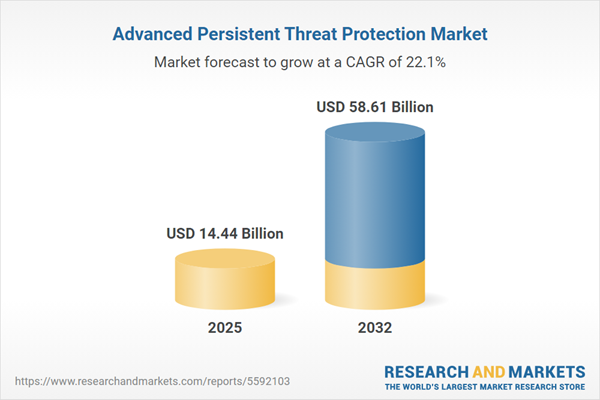Speak directly to the analyst to clarify any post sales queries you may have.
Senior leaders recognize that robust advanced persistent threat protection is now fundamental for navigating complex cyber risks, guiding strategic decisions, and supporting sustainable digital transformation. Investing in intelligence-driven security solutions ensures resilience and adaptability, fostering trust across stakeholders amidst shifting regulatory and operational demands.
Market Snapshot: Advanced Persistent Threat Protection Market
The advanced persistent threat protection market is experiencing steady global expansion, reaching a value of USD 11.84 billion and projected to grow at a CAGR of 22.12%. With expectations to attain USD 14.44 billion by 2025 and surpass USD 58.61 billion by 2032, the sector’s evolution is propelled by escalating threat sophistication and the adoption of comprehensive cyber defense strategies. Leadership teams utilize purpose-built technologies to boost threat intelligence, accelerate response times, and enable growth-aligned security postures. Vendors are focusing on automation, system interoperability, and regulatory adaptation to elevate enterprise-wide resilience and compliance readiness.
Scope & Segmentation
This research provides granular segmentation and actionable benchmarks for executives responsible for enterprise risk management and cybersecurity strategies. The analysis equips organizations to direct investment toward outcomes that reinforce security, enable compliance, and empower digital initiatives across industries and geographies.
- Component: Security domains include cloud security, endpoint protection, email security, and network security, each protecting essential digital assets from an expanding range of sophisticated attack vectors.
- Deployment Mode: Flexible models such as cloud, on-premises, and hybrid implementations address sector-specific workflows in public and private organizations.
- Organization Size: Solutions are structured to meet unique needs of large enterprises, midmarket businesses, and SMBs, supporting tailored risk management strategies.
- Industry Vertical: Market approaches address specialized challenges such as data privacy, financial transaction integrity, business continuity, and regulatory compliance in sectors like finance, healthcare, telecommunications, retail, and government.
- Distribution Channel: Options include purchases through direct vendors, system integrators, distributors, and authorized resellers, broadening accessibility and procurement flexibility for organizations of all sizes.
- Threat Type: Multi-layered security platforms respond to evolving threats, including advanced malware, zero-day exploits, ransomware, and phishing attacks, enabling resilient operations in volatile risk environments.
- Geographies: Adoption and solution preferences vary based on regional regulatory frameworks, infrastructure maturity, and each organization's approach to risk—impacting how cybersecurity investments are prioritized worldwide.
- Key Market Participants: Leaders such as Palo Alto Networks, FireEye, Trend Micro, Check Point, Fortinet, CrowdStrike, Cisco, Microsoft, McAfee, and Sophos offer specialized solutions to address complex enterprise requirements.
Key Takeaways
- Machine learning and advanced analytics heighten early threat identification and streamline response, improving operational reliability and incident mitigation across changing environments.
- Cloud-native and hybrid architectures provide organizations with adaptability to evolving regulatory expectations, supporting both compliance and business agility as governance requirements shift.
- Access management tools and expanded technology partner ecosystems help organizations enhance compliance coverage, securing broader supply chain and business networks.
- Managed security services offer continuous monitoring and support, helping organizations supplement in-house skills and control operational expenses for greater stability.
- Industry-focused risk frameworks empower leaders to align security investments with sector-specific demands, prioritizing protection of sensitive data and maintaining uninterrupted operations.
- Strategic procurement partnerships ease solution adoption and deployment, minimizing complexity for organizations navigating new or tightening regulatory mandates.
Tariff Impact: Navigating Global Supply Chain Changes
Anticipated tariffs on security hardware and semiconductor components are influencing procurement strategies through 2025. Enterprises are increasing their use of regional sourcing, extending device lifecycles, and prioritizing software-centric and cloud-native alternatives. These approaches help organizations maintain operational continuity and reinforce vendor relationships during times of supply chain upheaval.
Methodology & Data Sources
This report employs a multifaceted research process combining technical analysis, regulatory examination, and direct engagement with solution vendors. Validation from independent cybersecurity experts ensures alignment with executive priorities and current market realities.
Why the Advanced Persistent Threat Protection Market Report Matters
- Enables executives to optimize cybersecurity strategies and improve oversight of digital risk mitigation initiatives.
- Supports procurement leaders in identifying adaptive technologies while establishing resilient, collaborative vendor frameworks in response to evolving threats.
- Provides actionable insights for building organizational resilience and improving preparedness for cybersecurity regulations and risks.
Conclusion
Comprehensive advanced persistent threat protection is essential for maintaining business resilience and operational continuity. This research empowers leaders with the strategic clarity needed to respond effectively to emerging cyber challenges.
Additional Product Information:
- Purchase of this report includes 1 year online access with quarterly updates.
- This report can be updated on request. Please contact our Customer Experience team using the Ask a Question widget on our website.
Table of Contents
3. Executive Summary
4. Market Overview
7. Cumulative Impact of Artificial Intelligence 2025
Companies Mentioned
The companies profiled in this Advanced Persistent Threat Protection market report include:- Palo Alto Networks, Inc.
- FireEye, Inc.
- Trend Micro Incorporated
- Check Point Software Technologies Ltd.
- Fortinet, Inc.
- CrowdStrike Holdings, Inc.
- Cisco Systems, Inc.
- Microsoft Corporation
- McAfee Corp.
- Sophos Group plc
Table Information
| Report Attribute | Details |
|---|---|
| No. of Pages | 184 |
| Published | October 2025 |
| Forecast Period | 2025 - 2032 |
| Estimated Market Value ( USD | $ 14.44 Billion |
| Forecasted Market Value ( USD | $ 58.61 Billion |
| Compound Annual Growth Rate | 22.1% |
| Regions Covered | Global |
| No. of Companies Mentioned | 11 |









